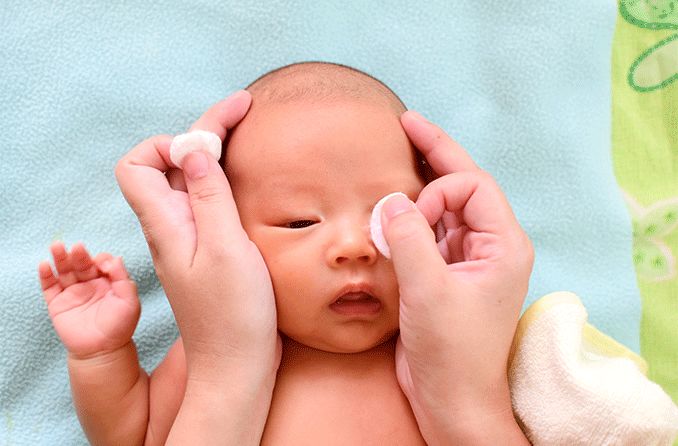Eye discharge in newborns, babies and toddlers: Causes and treatment

Eye discharge in toddlers and babies is common and usually harmless. Eye discharge often occurs due to a blocked tear duct, allergies or a viral infection — which can usually be treated at home. However, some cases may lead to infection or be a sign of a more significant underlying condition.
If your baby or toddler experiences constant eye discharge, if eye discharge gets worse or if additional symptoms occur, contact an eye care provider for advice.
What causes eye discharge in toddlers and babies?
Many cases of eye discharge in young children have common underlying causes, including allergies, infection, blocked tear ducts and more. Treatment for eye discharge in babies and toddlers varies depending on the cause.
Normal eye discharge
It is normal for infants and toddlers to experience a small amount of discharge in the corner of their eyes, whether it appears wet, mucousy or crusty. This is often due to mucus secreted during sleep (sleep in the eye), but can also be caused by a child wiping their eye with dirty hands.
Conjunctivitis
Eye discharge is a common symptom of eye infections such as viral and bacterial conjunctivitis, which are both highly contagious. Bacterial conjunctivitis will sometimes require an antibiotic to clear up, but viral conjunctivitis (pink eye) simply has to clear up on its own.
Viral conjunctivitis (pink eye)
Viral pink eye is caused by a virus, such as the common cold, and typically occurs in both eyes. Discharge associated with viral pink eye is usually watery and clear, but a white or light yellow-colored mucus may occur.
Eye discharge in babies with a cold can usually be treated at home, but infections should be treated by a eye care provider.
Bacterial conjunctivitis
Bacterial conjunctivitis occurs when harmful bacteria enter the eye, and it is usually only present in one eye. Discharge that occurs with bacterial conjunctivitis is more pus-like than the discharge that occurs with viral pink eye. The thickness of bacterial discharge can cause eyes to have trouble opening and closing and can appear yellow, green or even grey in color.
It can be difficult to tell the difference between viral and bacterial conjunctivitis, so consult with your child's pediatrician or eye care provider if you suspect conjunctivitis.
Allergies
Seasonal eye allergies or sensitivities to environmental factors, including smoke, pollen, dust, pet dander, etc., can cause inflammation of the conjunctiva (allergic conjunctivitis). The inflammation can cause eyes to produce a watery discharge, and if the reaction is severe enough, an infection may also develop.
Stye
A stye is a painful, pimple-like bump that occurs when an eyelash follicle or eyelid oil gland becomes infected. A stye typically causes redness, discomfort and some swelling in the affected eye. Yellow pus may also be present with a stye, as well as discharge if the stye pops.
Eye injury/object in eye
If the eye is injured or if a foreign object (such as a child’s toy, dirt or debris) enters the eye, a watery discharge may be secreted as part of the eye’s natural protective response. Eye injuries should be evaluated by an eye care provider as soon as possible for proper care, especially if eye discharge or blood in the eye (subconjunctival hemorrhage) is present.
Blocked tear ducts in infants
Many babies are born with obstructed tear ducts, which can cause tears to drain improperly and lead to watery eyes and/or mild discharge. One of the key symptoms of obstructed tear ducts in babies is significant pooling of tears, which can occur with or without crying.
If you notice your baby is experiencing eye discharge or goopy eyes, keep the eye area clean and wipe it when needed with a clean, damp washcloth. A gentle massage of the area can help unblock the tear duct.
How to treat eye discharge in toddlers and babies
Treatment of eye discharge in toddlers and babies depends on the cause and severity of the case. Keeping the area clean and wiped free of discharge is a priority. Mild eye discharge can be treated at home by:
Avoiding irritants that may have caused an allergic reaction
Gently wiping away discharge with a clean washcloth or cotton swab as needed
Applying a warm compress for discharge caused by infection, stye or blocked tear duct
Gently massaging the eye area for discharge caused by a blocked tear duct or stye
Applying a child-safe eye ointment or natural tears if dryness is present
Help your toddler to wash his or her hands frequently if an eye infection occurs or if eyes become irritated or produce frequent discharge. While home treatments can help relieve eye discharge in your child, infections may require antibiotics prescribed by an eye care provider.
When to see an eye care provider for eye discharge in babies and toddlers
Because of their age and stage of development, very young children are not always able to verbally express symptoms of an eye condition, regardless of whether it is mild or severe. In addition, eye discharge has varying causes, which can make it difficult to pinpoint a problem.
It is important to take note of the following symptoms that may accompany eye discharge in your child:
Constant rubbing or touching of the eye
Trouble opening or closing the eye
Yellow or green discharge
Discharge that is especially thick in texture
Discharge that lasts longer than a few days
It may be necessary to contact an eye care provider if your child experiences eye discharge for more than a few days, whether or not additional symptoms are present, in order to address the issue completely. Although eye discharge can often be remedied at home, some cases may require evaluation and treatment from an eye care provider to prevent further problems.
Page published on Tuesday, 17 May 2022






